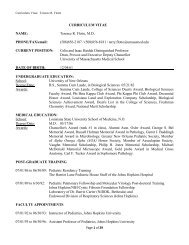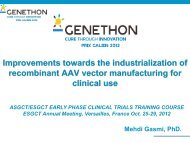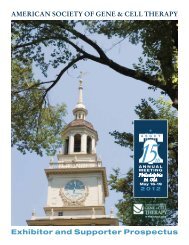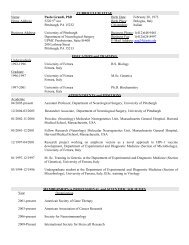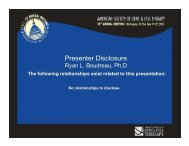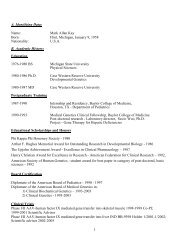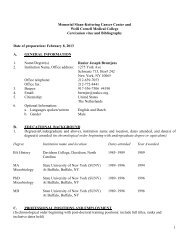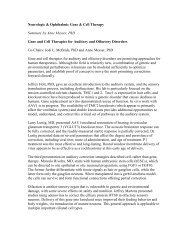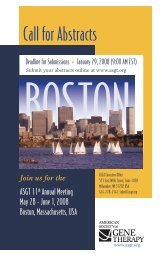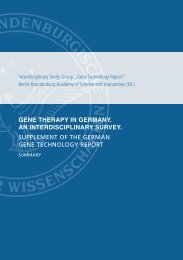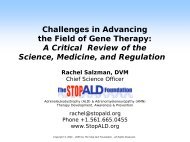FINAL PROGRAM - American Society of Gene & Cell Therapy
FINAL PROGRAM - American Society of Gene & Cell Therapy
FINAL PROGRAM - American Society of Gene & Cell Therapy
- No tags were found...
Create successful ePaper yourself
Turn your PDF publications into a flip-book with our unique Google optimized e-Paper software.
13 th AnnUAL MEETing | Washington, DC USA May 19-22, 2010 57Program ScheduleScientific Symposium 31310:30 am - 12:30 pmRoom: Maryland SuitePrecise <strong>Gene</strong>tic and Post-transcriptional Modification <strong>of</strong> Stem <strong>Cell</strong>sChairDieter C. Gruenert, PhDSpeakersPeter M. Glazer, MD, PhDTargeted <strong>Gene</strong> Modification in Hematopoietic Stem <strong>Cell</strong>s via Triple Helix FormationTriple helix-forming peptide nucleic acids (PNAs) can bind to polypurine regions in DNA in a sequence-specific manner. The resulting triplexes constitute an altered DNAstructure that can stimulate DNA repair and recombination in a site-specific manner in human cells. We have found that transfection <strong>of</strong> human hematopoietic stem cellswith triplex-forming PNAs plus short single-stranded donor DNAs can produce targeted modification <strong>of</strong> disease related genes. Site-directed modification <strong>of</strong> two key humangenes has been achieved: (1) the human beta-globin gene, mutations in which cause thalassemia and sickle cell anemia; and (2) the CCR5 gene, which encodes aco-receptor for HIV-1 entry into human cells. Triplex-modified hematopoietic stem cells have been transplanted into immune deficient mice, with full engraftment, normalpatterns <strong>of</strong> differentiation, and persistence <strong>of</strong> the targeted gene modification for up to four months.Linzhao Cheng, PhD<strong>Gene</strong> Targeting in Human Pluripotent Stem <strong>Cell</strong>sHuman induced pluripotent stem (iPS) cells reprogrammed from adult somatic cells resemble embryonic stem (ES) cells that can proliferate indefinitely in culture whilemaintain their full differentiation potential (pluripotency), therefore providing an unlimited resource for disease research and therapy. These self-renewable stem cells alsomake it feasible to achieve gene targeting (to correct or create DNA mutation) in the genome <strong>of</strong> normal human cells by homologous recombination (HR) that is naturalbut inefficient process for genome repair. To enhance HR-mediated gene targeting efficiency we also incorporate the strategy utilizing zinc finger nuclease (ZFN), whichis designed as a fusion protein with multiple zinc-finger DNA binding and the FokI endonuclease domains. Upon dimer formation, two ZFNs (co-delivered with a donorDNA template) can create a sequence-specific DNA double strand break to stimulate HR near the cut site. We found that ZFNs enhanced HR by >100-1,000 fold in eithercreating or correcting a mutation in human iPS and ES cells.Dieter C. Gruenert, PhDModification <strong>of</strong> the CF and Sickle <strong>Cell</strong> Anemia iPS cells by SFHRInduced pluripotent stem (iPS) cells have the potential <strong>of</strong> significantly advancing the development <strong>of</strong> stem cell-based therapies, especially as they pertain to inheriteddiseases. The potential to generate autologous pluripotent stem cells to repair and regenerate tissues and organs damaged by disease pathologies is a cornerstone <strong>of</strong>patient-specific therapy. Cystic fibrosis (CF), the most common inherited disease in the Caucasian population, and sickle cell anemia (SCA), the most prevalent hemoglobinopathycommonly found in individuals <strong>of</strong> African, Middle Eastern, Mediterranean, and Southeast Asian decent, have significant multiorgan damage that will benefit fromcellular repair. In this context, somatic cells from a CF patient with a ∆F508/∆F508 genotype and a SCA patient have been reprogrammed, characterized, and correctedby small fragment homologous replacement (SFHR).Robert Blelloch, MD, PhDMicroRNA Regulation <strong>of</strong> Embryonic Stem <strong>Cell</strong> Self-Renewal and DifferentiationFriday, May 21 st



